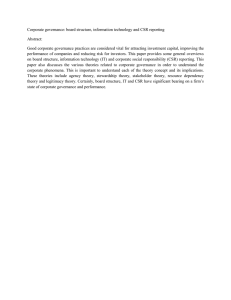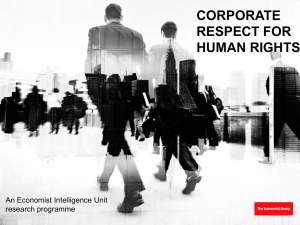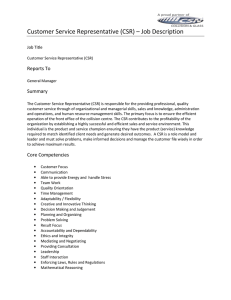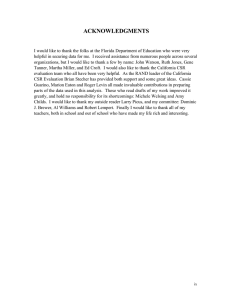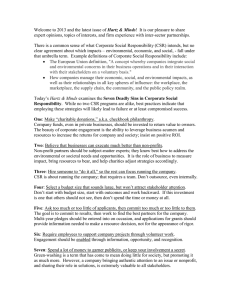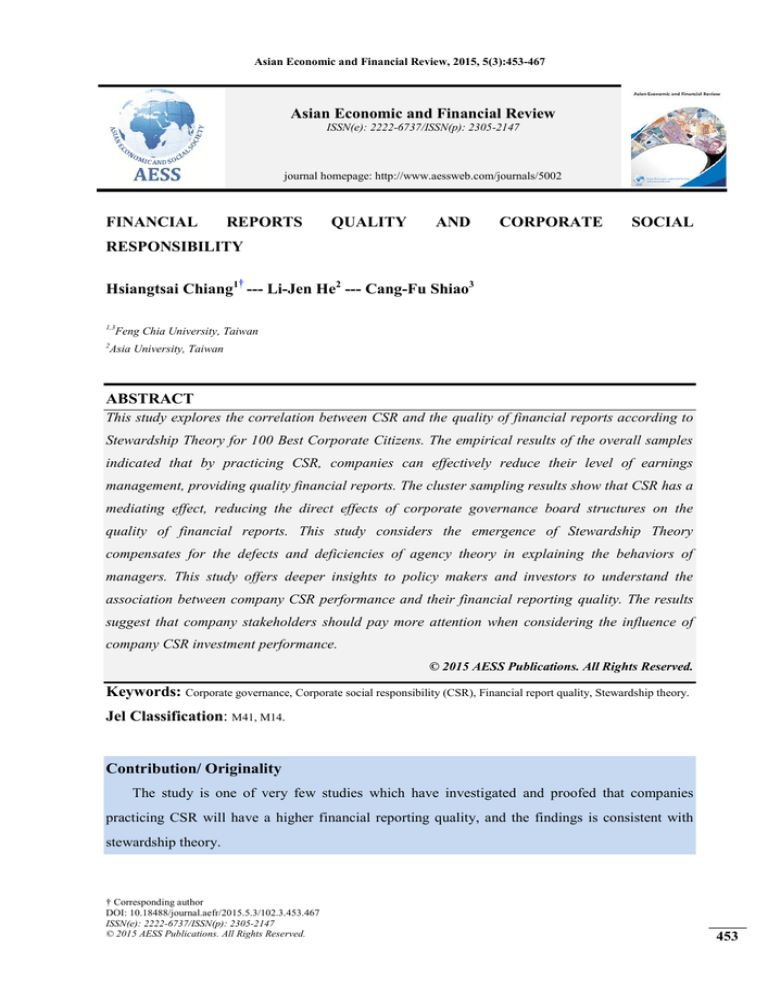
Asian Economic and Financial Review, 2015, 5(3):453-467
Asian Economic and Financial Review
ISSN(e): 2222-6737/ISSN(p): 2305-2147
journal homepage: http://www.aessweb.com/journals/5002
FINANCIAL
REPORTS
QUALITY
AND
CORPORATE
SOCIAL
RESPONSIBILITY
Hsiangtsai Chiang1† --- Li-Jen He2 --- Cang-Fu Shiao3
1,3
Feng Chia University, Taiwan
2
Asia University, Taiwan
ABSTRACT
This study explores the correlation between CSR and the quality of financial reports according to
Stewardship Theory for 100 Best Corporate Citizens. The empirical results of the overall samples
indicated that by practicing CSR, companies can effectively reduce their level of earnings
management, providing quality financial reports. The cluster sampling results show that CSR has a
mediating effect, reducing the direct effects of corporate governance board structures on the
quality of financial reports. This study considers the emergence of Stewardship Theory
compensates for the defects and deficiencies of agency theory in explaining the behaviors of
managers. This study offers deeper insights to policy makers and investors to understand the
association between company CSR performance and their financial reporting quality. The results
suggest that company stakeholders should pay more attention when considering the influence of
company CSR investment performance.
© 2015 AESS Publications. All Rights Reserved.
Keywords: Corporate governance, Corporate social responsibility (CSR), Financial report quality, Stewardship theory.
Jel Classification: M41, M14.
Contribution/ Originality
The study is one of very few studies which have investigated and proofed that companies
practicing CSR will have a higher financial reporting quality, and the findings is consistent with
stewardship theory.
† Corresponding author
DOI: 10.18488/journal.aefr/2015.5.3/102.3.453.467
ISSN(e): 2222-6737/ISSN(p): 2305-2147
© 2015 AESS Publications. All Rights Reserved.
453
Asian Economic and Financial Review, 2015, 5(3):453-467
1. INTRODUCTION
The term corporate social responsibility (CSR) is not recent; however, its definition and
content have gradually been expanded and extended by the development of historical background,
and it differs substantially from its original meaning. Corporations previously focused exclusively
on financial and economic factors, vigorously pursuing the maximization of shareholder interests.
A transitional period followed, in which perceptions of CSR gradually expanded to improving the
work environments and equity of employees. Contemporary perceptions of CSR are based on the
ultimate objectives of corporations such as sustainable management and contributions to society,
which is the source of corporate profits. After realizing the interdependence and inseparability of
CSR promotion and shareholder equity, corporations expanded their environmental protection and
social welfare efforts, and commitment to satisfying the basic profitability objectives and
stakeholder requirements.
A report by the World Business Council for Sustainable Development indicated that when
corporations promote CSR, issues related to core company values can be categorized into worker
equity, human rights, environmental protection, community participation, relationships with
suppliers, transparency and disclosure, and stakeholder equity. This report highlights the wide
range of dimensions covered by CSR. However, mainstream studies in the accounting field have
continued to explore the relationships between CSR and stakeholder equity. Few studies have
analyzed whether voluntarily disclosing CSR-type information affected transparency and
disclosure, delivered additional information, or increased company value.
Financial reports provide the basis for policy decisions by the investing public and high quality
financial reports can increase company value. Thus, whether a CSR investment influences the
earnings manipulation of high-level corporate personnel has attracted considerable attention.
Previous studies have followed the assumptions of agency theory, which suggest that managers are
self-serving and only promote CSR when it yields benefits. Corporations invest in CSR to
camouflage their manipulation of earnings, negatively affecting the quality of financial reports
(Prior et al., 2008). In contrast to agency theory, other scholars proposed stewardship theory,
maintaining that managers are organization-oriented. This perspective explains why managers
actively implement CSR when no short-term returns on investment exist. This standpoint was
employed to re-examine the relationship between CSR and the quality of financial guarantees.
Previous studies have indicated that board structure of corporate governments affects the quality of
financial reports and CSR. Therefore, this study involved exploring the role of CSR by examining
the relationships among CSR, corporate governance, and the quality of financial reports.
The rest of this paper reviews the literature and develops the research hypotheses of related to
CSR and Stewardship Theory, empirically tests the hypotheses and provides conclusions about the
results.
© 2015 AESS Publications. All Rights Reserved.
454
Asian Economic and Financial Review, 2015, 5(3):453-467
2. LITERATURE REVIEW AND HYPOTHESES DEVELOPMENT
Recently, corporate investors, customers, and stakeholders have focused on CSR-related
topics; this is primarily because the involuntary disclosure of information involved in CSR, which
investors can use to assess and understand corporations. Thus, CSR is frequently discussed. Grant
(2008) asserted that CSR should not be limited to the development of large corporations, but should
be employed by all corporations. Recent mainstream CSR research has explored the correlation
between CSR and financial performance. Scant research has investigated the relationship between
CSR and the quality of financial reports; because of the differences in the agency and stewardship
theories regarding manager behavior, no unified conclusion exists within the current literature.
Initially, corporate governance was developed to solve the agency problem that resulted from
separating ownership and management rights. As a result, agency theory rapidly developed,
becoming the mainstream theory for corporate governance. Since the 1997 Asian financial crisis,
agency theory (which is based on self-interest) has been inadequate for explaining corporate
governance issues and numerous flaws have been identified in its system. Bad publicity regarding
“fat cat” supervisors has led scholars to reflect on and review agency theory. Thus, the altruismbased stewardship theory was developed and seriously analyzed. On a certain level, stewardship
theory compensated for the flaws in agency theory. The difference between the agency and
stewardship theories is similar to the difference between the innate goodness and innate evil
concepts in the Confucian thinking that is prevalent in Taiwan.
2.1. The Influence of Stewardship Theory and Agency Theory on CSR
Agency theory appeared in its earliest form in a report by Berle and Means (1932). When
corporations attempted to locate additional external resources and funding to achieve and maintain
competitiveness, the funding providers were often not the managers of the corporation. This
generated a separation between corporate management rights and ownership. When managers hold
little share in the company and ownership rights are dispersed (making it difficult for owners to
effectively constrain managers), they may deviate from the objectives of the corporate management
to maximizing their self-interests; this situation caused an agency problem, which agency theory
was developed to relieve (produced by the agent relationship), reducing agency costs. This was
accomplished by establishing an oversight mechanism and contract award incentive, allowing
managers to simultaneously maximize personal and shareholder interests (Jensen and Meckling,
1976; Fama and Jensen, 1983).
Stewardship Theory was developed by Davis et al. (1997) by using Theories X and Y, which
were established by McGregor (1960). This theory assumed that two opposite types of people exist,
one of which demonstrates passive work motivation (X theory) and one of which demonstrates
active work motivation (Y theory, also called innate goodness theory). These assumptions were
used to explain why agency theory mechanisms failed in current society. Agency Theory involves
© 2015 AESS Publications. All Rights Reserved.
455
Asian Economic and Financial Review, 2015, 5(3):453-467
one-sided assumptions regarding managerial behavior. In the real world, certain managers achieve
intrinsic satisfaction or obtain the recognition of others by completing the tasks assigned by their
organizations. This desire for self-actualization allows their behaviors to surpass the limitations of
money and other incentives. Stewardship theory holds that certain managers possess innate
goodness, pursuing the maximal benefit to shareholders as a primary objective and valuing their
commitments toward the organization. In organizations, these managers play the roles of stewards,
safeguarding the benefits of the corporation. Manager behavior is driven by social perceptions and
self-achievement. Thus, the self-interests of managers and benefits to the company and all company
personnel are mutually linked, and no conflicts arise (Block, 1996; Davis et al., 1997; Peggy and
Hugh, 2001).
Previous explorations of CSR were often founded on the assumptions of Agency Theory. In
other words, managers are driven by self-interest, viewing CSR as simply a tool, and promoting
CSR activity only when it yields benefits (Friedman, 1970; Shank et al., 2005; Karnani, 2010;
Dhaliwal et al., 2011). For example, Kim and Venkatachalam (2011) indicated that in the gambling
and tobacco industries, corporations developed CSR to improve their business reputations. Based
on this self-interest perspective, scholars discovered that corporations invested in CSR to
camouflage earnings manipulations, resulting in a negative relationship between CSR and the
quality of financial reports (Prior et al., 2008). However, certain scholars indicated that CSR
affected the quality of financial reports in various ways depending on proxy variables (Chih et al.,
2008).
Alternate scholars have asserted that corporations often develop CSR even if it reduces the
benefits of corporate stakeholders (Carroll, 1999; Friedman et al., 2005; Grow et al., 2005;
Kolstad, 2007; Reinhardt et al., 2008). The perspectives of these scholars are biased toward
stewardship theory, maintaining that managers are influenced by self-actualization and morals,
often electing to do things that benefit the company and avoiding poor social behaviors, even if
doing so reduces the short-term benefits to corporate stakeholders. Thus, managers are not affected
by self-interests when they promote corporate policies. According to this theoretical perspective,
managers avoid behaviors that harm the company, demonstrating of self-restraint and not using
CSR to conceal earnings manipulations. This reduces the degree of earnings management by
managers, resulting in high-quality financial reports. Therefore, Hypothesis 1 was established to
verify the correlation between CSR and the quality of financial reports as follow:
Hypothesis 1: Corporations that demonstrate superior CSR performance provide high-quality
financial reports.
2.2. The Mediation Effect of CSR
Studies of both the stewardship and agency theories have continued to explore how board
structures affect corporate governance mechanisms. A highly independent board can increase the
© 2015 AESS Publications. All Rights Reserved.
456
Asian Economic and Financial Review, 2015, 5(3):453-467
supervision and control over managers. Combining the chairman of the board and the CEO
positions and increasing inside directors can allow the manager to function in the role of the
steward in high-trust environments. From a corporate governance perspective, the board is
responsible for hiring and dismissing corporate managers, setting a reward system, and supervising
the performance levels of corporate policies. Therefore, the board structure provides a critical
internal control mechanism for corporate governance.
Previous studies of the correlation between corporate governance and the quality of financial
reports used agency theory as a basis for exploring how board structures affected the quality of
financial reports. These scholars have maintained that when a chairman of the board served as the
CEO, the dual managerial position reduced the supervisory function of the board. This increased
the incentive for the manager to conduct earnings management, thereby, producing inferior quality
financial reports (Core et al., 1999; Shivdasani and Yermack, 1999; Anderson et al., 2004).
Regarding board independence, agency theory maintains that the lower the ratio of inside directors,
the more effective it is for the board to implement supervisory functions, because no close
relationship exists between the board and the manager, which facilitates implementation of internal
corporate governance and reduces the likelihood of managers manipulating earnings (Dechow et
al., 1996; Hillman and Dalziel, 2003).
However, stewardship theory maintains that managers link the success or failure of the
company to themselves by using self-actualization. When they encounter the dual position problem
posed by combined chairman of the board and CEOs, managers become comparatively more
concerned about their commitment toward the organization (Boyd, 1995) and consequently less
likely to engage in earnings management. Regarding board independence and structure,
stewardship theory involves a distinct view compared with agency theory. Stewardship Theory
maintains that boards should be formed by inside directors, who should familiarize themselves with
company operations, aiding the directors in executing their functions (Corbetta and Salvato, 2004).
Previous studies have also indicated that the corporate governance mechanism of board
structure can influence CSR investment. Johnson and Greening (1999) explored the correlation
between internal corporate governance mechanisms and CSR performance levels by examining the
proportion of outside directors and the ratios of shares held by managers and investors,
subsequently evaluating the effectiveness of those mechanisms. The results showed that efficient
internal governance mechanisms yielded a strong social responsibility performance levels.
However, certain scholars have maintained that inside directors are committed to charitable
activities; thus, when a high proportion of inside directors is present, a corporation is expected to
perform relatively frequent charitable undertakings (Wang and Coffey, 1992). Stewardship theory
maintains that when the chairman of the board acts as the CEO, he or she is expected to combine
self- and corporate interests. The behavior of the CEO is influenced by social perceptions; thus, he
or she is expected to heavily invest into CSR (Davis et al., 1997). However, agency theory
© 2015 AESS Publications. All Rights Reserved.
457
Asian Economic and Financial Review, 2015, 5(3):453-467
maintains that the closer the relationship between a corporation and its stakeholders is, the more it
actively invests in CSR. Thus, the concentration of authority generated by dual positions should be
avoided. Previous studies have reported that the corporate governance mechanism of board
structure influences CSR investments and the quality of financial reports. However, CSR may be
critical to influencing the quality of financial reports; thus, its role in corporate governance and the
quality of financial reports is notable. In other words, a mediating effect may exist between
corporate governance and the quality of financial reports. Therefore, Hypothesis 2 was established
to test whether CSR was a mediating variable between corporate governance and the quality of
financial reports as follow:
Hypothesis 2: CSR mediates the influence of corporate governance on the quality of financial
reports.
3. RESEARCH METHODOLOGY
3.1. Source of Data
Corporations were selected from the 2009–2011 editions of the 100 Best Corporate Citizens
List, which is published annually by the Corporate Responsibility Office. Of 300 corporations, 34
were eliminated for a lack of related financial data and 45 exclusive or oligopolistic corporations
were rejected, forming the experimental group. The pairing method was used to form a comparison
group based on industry type, and total assets and sales. The samples comprised 442 corporations,
with 221 corporations that implemented CSR and 221 that did not implement CSR. Regarding
corporate governance variables, dual position data and the number of inside directors were obtained
from 10-K and def-14a forms in the U.S. Securities and Exchange Commission website. Finance
data for the sample corporations were collected from the Standard & Poor’s COMPUSTAT (North
American edition).
3.2. Empirical Model
First, a multiple regression analysis was employed to examine how CSR affected the quality of
financial reports. Estimations were conducted by employing ordinary least squares (OLS). Multiple
regression Equation (1) was established to verify Hypothesis 1.
FQRt ( DA or RAM ) 0 1CSR 2 NEGCFOt 1 3 LOSSDt 1 4 LEVt 1
5 BETAt 1 6OCt 1
…(1)
Financial reporting quality (FRQ) is measured by discretionary accruals and real earnings
management of companies of companies. Discretionary accruals (DA) are measured from the
model provide by Kothari et al. (2005), and are divided into positive and negative DA based on its
value and its absolute value obtained (ABS_DA). Real earnings management (RAM) is measured
from the model proposed by Roychowdhury (2006) and Cohen et al. (2008), and is divided into
cash flow from abnormal operating activities (AB_CFO), abnormal production costs (AB_PROD),
© 2015 AESS Publications. All Rights Reserved.
458
Asian Economic and Financial Review, 2015, 5(3):453-467
abnormal discretionary expenditure (AB_DISEXP), and the RAM comprehensive index RAM (AB_CFO + AB_PROD - AB_DISEXP).
Corporate social responsibility (CSR) is an indicator variable that equal to one when sample
company is one of the 100 Best Corporate Citizens. Both NEGCFO and LOSSD are indicator
variables which are taken to be one for the negative value of operating cash flow and profit for the
quarter. LEV is the debt ratio which was measured by the total liabilities divided by total assets of a
company. BETA represents the systematic risks to the corporate asset, and a value greater than 1
represents that the risk is higher than market volatility. Finally, Operating cycle (OC) is measured
by the average number of the summation of accounts receivable collection and the average number
of inventory turnover days. Second, this study verified whether CSR was a mediating variable in
corporate governance variable, influencing financial report quality. Based on the method of Baron
and Kenny (1986), regression Equation (1) was used to establish regression Equation (2) to
sequentially verify (3) whether a significant correlation exited between the mediating variable and
dependent variable, independent variable and mediating variable, and independent variable and
dependent variable. When these correlations were established, the mediating variable was placed in
regression Equation (4). If the effects of independent variables were weakened or eliminated, it
suggested mediating effects.
(a)
Verifying whether a significant correlation existed between the independent variable
(corporate governance) and dependent variable (financial report quality).
FQRt ( DA or RAM ) 0 1 INSIDERt 2 DUALITYt 1
…(2)
(b) Verifying whether a significant correlation existed between the independent variable (corporate
governance) and mediating variable (CSR).
CSRt 0 1 INSIDERt 2 DUALITYt 1
… (3)
(c) Verifying whether the effects of the independent variable (corporate governance) were reduced.
FQRt ( DA or RAM ) 0 1CSR 2 INSIDERt 3 DUALITYt 4 NEGCFOt 1
5 LOSSEDt 1 6 LEVt 1 7 BETAt 1 8OCt 1
…(4)
INSIDER represent the ratio of inside directors and was measured by dividing the number of
inside directors and related directors by the scale of the board. DUALITY represents the dual
positions of managers and is equal to one when the chairman of the board is acting in the role of
CEO.
4. RESULTS AND ANALYSIS
4.1. Descriptive Statistic Analysis
Prior to conducting the regression analysis, a descriptive statistical analysis was conducted for
the overall and cluster samples and the variables to elucidate the differences between and
characteristics of the samples, facilitating subsequent research. Companies on the 100 Best
© 2015 AESS Publications. All Rights Reserved.
459
Asian Economic and Financial Review, 2015, 5(3):453-467
Corporate Citizens List from 2009 to 2011 were used as the study samples. Companies that
demonstrated excellent CSR performance levels were paired with companies that demonstrated
poor CSR performance levels to form the overall samples. After eliminating oligopolistic industries
and samples that lacked data, the valid samples comprised 442 companies. Tables 1 and 2 show the
mean, median, standard deviation, and quartile descriptive statistic results for each variable.
Tables 1 and 2 show that companies that demonstrated excellent levels of CSR performance
produced financial reports of superior quality, exhibiting fewer discretionary accruals
manipulations than did companies that demonstrated poor levels of CSR performance. Regarding
real earnings management, companies that achieved excellent CSR performance levels were
relatively more conservative, and had less real earnings management in all three dimensions and
the combined indicators compared with the controls. Concerning independent variables, the
experimental group demonstrated a lower inside director ratio (0.135 < 0.177) and often a higher
value in chairman of the board acting as CEO (0.75) compared with the controls (0.57). For control
variables, the cluster samples showed significant differences in BETA, NEGCFO, LEV, and
LOSSD. The control group demonstrated comparatively higher system risks compared with the
experimental group, easily generating negative cash flows and losses.
Table-1. Full Sample Descriptive Statistics
Mean
Median
S.D.
Min.
Max.
Dependent Variables
ABS_DA
0.035
0.023
0.045
0.0002
0.432
Positive_DA
0.033
0.021
0.044
0.0002
0.432
Negative_DA
-0.037
-0.026
0.045
-0.403
-0.0003
DA
0.002
0.005
0.057
-0.403
0.432
AB_CFO
-0.004
-0.007
0.065
-0.414
0.215
AB_PROD
0.006
0.012
0.161
-0.846
0.549
AB_DISEXP
0.002
-0.022
0.190
-0.371
1.198
RAM
0.007
0.045
0.360
-2.089
1.012
Independent Variables
CSR
0.500
0.500
0.501
0.000
1.000
INSIDER
0.156
0.125
0.086
0.000
0.546
DUALITY
0.660
1.000
0.475
0.000
1.000
Control Variables
NEGCFO
0.030
0.000
0.163
0.000
1.000
LOSSD
0.130
0.000
0.338
0.000
1.000
LEV
0.609
0.615
0.184
0.147
0.729
BETA
1.957
1.041
10.135
0.664
1.461
OC
4.702
4.629
0.829
4.304
4.969
© 2015 AESS Publications. All Rights Reserved.
460
Asian Economic and Financial Review, 2015, 5(3):453-467
DA: discretionary accruals; RAM: Real earnings management, is divided into cash flow from
abnormal operating activities (AB_CFO), abnormal production costs (AB_PROD), abnormal
discretionary expenditure (AB_DISEXP), and the RAM comprehensive index RAM (-AB_CFO +
AB_PROD - AB_DISEXP); CSR: is 1 when sample company is one of the 100 Best Corporate
Citizens otherwise 0. INSIDER: represent the ratio of inside directors and was measured by
dividing the number of inside directors and related directors by the scale of the board. DUALITY:
represents the dual positions of managers and is equal to one when the chairman of the board is
acting in the role of CEO.
Table-2. Grouped Sample Descriptive Statistics
CSR Companies
Non-CSR
Companies
Mean
Differences
P-value
Mean
Median
Median
Dependent Variables
ABS_DA
Positive_DA
0.028
0.031
0.021
0.022
0.041
0.036
0.025
0.021
0.002
0.530
Negative_DA
-0.025
-0.017
-0.047
-0.032
0.000
DA
0.008
0.007
-0.005
0.000
0.004
AB_CFO
0.001
-0.005
-0.009
-0.010
0.083
AB_PROD
-0.005
0.005
0.016
0.015
0.170
AB_DISEXP
0.009
-0.018
-0.005
-0.027
0.466
RAM
-0.015
0.034
0.029
0.058
0.030
Independent Variables
INSIDER
0.135
0.100
0.177
0.154
0.000
DUALITY
0.750
1.000
0.570
1.000
0.000
Control Variables
NEGCFO
0.010
0.000
0.040
0.000
0.058
LOSSD
0.060
0.000
0.200
0.000
0.000
LEV
0.630
0.622
0.589
0.601
0.008
BETA
1.060
0.910
2.854
1.174
0.064
OC
4.695
4.636
4.710
4.618
0.685
Stewardship
0.120
0.000
0.230
0.000
0.000
Variables are defined in Table 1.
4.2. Correlation between Variables
If a linear correlation exists between each variable, this can affect the explanatory power of the
variables. Therefore, a Pearson correlation coefficient was employed to analyze whether significant
correlations existed among the variables prior to conducting the regression analysis. Table 3 shows
the results of the correlation coefficient analysis, indicating that except for the combined indicator
of real earnings management and its three proxy variables (which have a high collinearity), the
© 2015 AESS Publications. All Rights Reserved.
461
Asian Economic and Financial Review, 2015, 5(3):453-467
correlation coefficients of the remaining variables were between -0.4 and 0.4. Thus, the model
generated no serious collinearity problems.
Table-3. Pearson Correlation
All Variables are defined in Table 1.
Statistical significance: *p < .05; **p < .01; ***p < .001.
4.3. CSR and Financial Report Quality
Tables 4 and 5 show the empirical results of Hypothesis 1
Regression analysis of CSR and discretionary accruals. Table 4 shows the proxy variable of
financial report quality, for which discretionary accruals were employed to examine the
relationship between CSR and financial report quality. The regression results were consistent with
expectations and CSR improved the quality of financial reports. Regarding earnings management,
CSR and the proxy variable ABS_DA exhibited a significant and negative correlation (p = .02).
This indicates that a company that demonstrates excellent CSR performance levels can reduce its
manipulation of discretionary accruals, subsequently improving the quality of financial reports. A
significant and positive correlation existed between Negative_DA and CSR (p < .01), indicating
that companies that demonstrate excellent CSR performance levels cease lowering profits and
losses to manage earnings. Although the Positive_DA results were non-significant, they were
consistent with expectations and can reduce the earnings manipulation that is conducted through
increasing gains or losses. Regarding the control variable, the negative cash flow of a company,
losses produced, and operating cycle were all significantly and positively correlated with ABS_DA.
This indicated that negative cash flow, operating losses, and long operating cycles can increase the
likelihood of manipulated discretionary accruals, consequently deteriorating the quality of financial
reports.
© 2015 AESS Publications. All Rights Reserved.
462
Asian Economic and Financial Review, 2015, 5(3):453-467
Table-4. Full Sample Regression Results(DA)
ABS_DA
Coefficient
(t-stat)
-0.112
(-2.326)
0.131
(2.720)
0.153
(3.145)
-0.006
(-0.133)
-0.051
(-1.082)
0.094
(1.995)
0.066
442
CSR
NEGCFO
LOSSD
LEV
BETA
OC
Adj R2
N
**
***
***
**
Negative_DA
Coefficient
(t-stat)
0.194
(2.705)
-0.053
(-0.743)
-0.108
(-1.505)
0.162
(2.304)
0.067
(0.981)
-0.078
(-1.117)
0.084
199
***
**
Positive_DA
Coefficient
(t-stat)
-0.053
(-0.840)
0.230
(3.344)
0.159
(2.428)
0.152
(2.403)
-0.094
(-1.397)
0.079
(1.251)
0.104
243
***
**
**
Variables are defined in Table 1. Statistical significance: *p < .05; **p < .01; ***p < .001
Regression analysis of CSR and real earnings management. Table 5 shows the proxy variable
for financial report quality, which involved used real earnings management to verify the regression
analysis results of Hypothesis 1. The results were similar to the regression analysis for
discretionary accruals. Companies that demonstrated excellent CSR performance levels reduced
their involvement in real earnings management, provided relatively more transparent financial
information, and subsequently improved their financial report quality compared with the control
group. In the combined indicator, CSR exhibited a negative correlation, reaching the 10% level of
significance. This indicated that CSR allows companies to remain conservative, reducing the
possibility of involvement in real earnings management. For abnormal production costs, CSR
exhibited a significant negative correlation. Thus, companies that demonstrated excellent CSR
performance levels can reduce the possibility of excessive production being used to manipulate
earnings. Although CSR remained non-significant regarding abnormal cash flow and abnormal
discretionary expenditure (p = .113 and .187), the value was extremely close to the 10% level of
significance. The expected result was consistent with Hypothesis 1, and can reduce the level of
earnings management. Concerning the control variable, when companies possessed high levels of
debt ratio and system risks, real earnings management showed a significant correlation to all three
proxy variables and the combined indicator, increasing the level of earnings management.
Table-5. Full Sample Regression Results (RAM)
CSR
NEGCFO
AB_CFO Coefficient
(t-stat)
AB_PROD Coefficient
(t-stat)
AB_DISEXP Coefficient RAM Coefficient
(t-stat)
(t-stat)
0.074
(1.588)
-0.196
(-4.240)
-0.078
(-1.662)
0.145
(3.085)
0.063
(1.321)
-0.026
(-0.544)
***
*
***
-0.081
(-1.737)
0.114
(2.434)
*
**
Continue
© 2015 AESS Publications. All Rights Reserved.
463
Asian Economic and Financial Review, 2015, 5(3):453-467
LOSSD
LEV
BETA
OC
Adj R2
N
-0.092
(-1.966)
-0.253
(-5.559)
-0.077
(-1.685)
0.065
(1.446)
0.135
442
*
-0.078
(-1.636)
0.121
(2.620)
0.104
(2.249)
-0.253
(-5.519)
0.105
442
***
**
***
**
***
0.111
(2.311)
-0.114
(-2.437)
-0.088
(-1.898)
0.267
(5.780)
0.092
442
**
**
**
***
-0.077
(-1.621)
0.160
(3.474)
0.107
(2.327)
-0.266
(-5.832)
0.117
442
***
**
***
Variables are defined in Table 1. Statistical significance: *p < .05; **p < .01; ***p < .001
Analysis of the mediating effect of CSR. Table 6 shows the test results for mediating effects
of CSR. When all three factors for mediating effects were satisfied, the regression results from
Equation (4) were subsequently examined to determine whether the mediating effects were
complete or partial. When the quality of financial reports was evaluated using discretionary
accruals, a partial mediating effect was evidenced, in which CSR served as the mediating variable
in the effects the ratio of inside directors in corporate governance structure have on financial report
quality. The mediating effect reduced the influence of the inside director ratio on financial report
quality (p increased from .006 to .015). When financial report quality was measured using real
earnings management, a complete mediating effect existed, negating the effects of duality on
financial report quality (p increased from .098 to .130). This explains why the cluster sample test
(Table 7) shows that the board characteristic of companies that demonstrated excellent CSR
performance levels non-significantly affected financial report quality. The mediating effects of
CSR reduced or eliminated the effects of corporate governance on financial report quality.
Table-6. Test results for mediating effects
Model (2)
DA
CSR
INSIDER
DUALITY
NEGCFO
LOSSD
LEV
BETA
OC
Adj R2
0.133
-0.053
Model (3)
CSR
RAM
***
0.02
-0.023
0.080
*
0.005
-0.205
0.144
***
***
0.073
Model (4)
DA
-0.083
0.121
0.000
0.130
0.157
0.007
-0.045
0.093
0.075
*
**
***
***
**
RAM
-0.105
-0.045
0.074
0.120
-0.065
0.147
0.109
-0.265
0.124
**
***
***
**
***
Variables are defined in Table 1. Statistical significance: *p < .05; **p < .01; ***p < .001
Table-7. Cluster sample test
INSIDER
DUALITY
CSR Companies
ABS_DA
Coefficient
(t-stat)
0.028
(0.385)
-0.072
(-0.954)
RAM
Coefficient
(t-stat)
0.096
(1.322)
0.060
(0.808)
Non-CSR Companies
ABS_DA
RAM
Coefficient
Coefficient
(t-stat)
(t-stat)
0.156
**
-0.132
**
(2.325)
(-2.150)
0.007
0.127
**
(0.099)
(2.063)
Continue
© 2015 AESS Publications. All Rights Reserved.
464
Asian Economic and Financial Review, 2015, 5(3):453-467
NEGCFO
LOSSD
LEV
BETA
OC
Adj R2
N
0.108
(1.451)
0.018
(0.253)
-0.050
(-0.719)
0.180
(2.659)
0.086
(1.278)
0.043
221
***
-0.009
(-0.117)
0.065
(0.907)
0.133
(1.944)
0.182
(2.706)
-0.167
(-2.496)
0.056
221
**
*
**
0.156
(2.323)
0.192
(2.850)
0.047
(0.699)
-0.055
(-0.815)
0.100
(1.503)
0.071
221
**
***
0.173
(2.815)
-0.120
(-1.948)
0.154
(2.498)
0.113
(1.843)
-0.341
(-5.615)
0.220
221
***
*
**
*
***
Variables are defined in Table 1.
Statistical significance:*p < .05; **p < .01; ***p < .001
5. CONCLUDING REMARKS
Since the Asian financial crisis, agency theory perspective has been increasingly challenged.
The emergence of stewardship theory compensates for the defects and deficiencies of agency
theory, explaining the behaviors of managers. According to stewardship theory, managers invest in
social responsibility because of self-actualization and morals, potentially influencing their
involvement in earnings management. This study comprised companies that demonstrated
excellent CSR performance levels from 2009 to 2011, assessing the correlation between CSR and
financial report quality. The empirical results indicated that CSR reduced the manipulation of
discretionary accruals and increased the quality of financial reports. Companies that demonstrate
excellent CSR performance levels can reduce decreases in profits or losses that manipulate
earnings. Regarding real earnings management, the combined indicators showed that CSR
facilitates comparatively conservative attitudes. CSR reduced the use of real operating activities to
manipulate earnings, particularly in abnormal production costs (e.g., increasing production
quantities to reduce unit costs). The cluster sample results indicated that CSR is a mediating
variable, which reduced the direct effects of corporate governance board structure on financial
report quality. Thus, investors should examine company CSR investment to evaluate the quality
and reliability of its financial statements and the direct effects of corporate governance board
structure on financial report quality. However, several limitations must be considered. The
financial and corporate governance data were collected from Standard & Poor’s COMPUSTAT
database and the SEC, but data gaps existed. The samples could not encompass all the appraised
companies, potentially compromising the results of this study. In subsequent studies, information
should be gathered from alternate appraisal organizations and global samples should be included,
rather than those from a single region.
REFERENCES
Anderson, R.C., S.A. Mansi and D.M. Reeb, 2004. Board characteristics, accounting report integrity, and the
cost of debt. Journal of Accounting and Economics, 37: 315-342.
© 2015 AESS Publications. All Rights Reserved.
465
Asian Economic and Financial Review, 2015, 5(3):453-467
Baron, R.M. and D.A. Kenny, 1986. The moderator-mediator variable distinction in social psychological
research: Conceptual, strategic, and statistical considerations. Journal of Personality and Social
Psychology, 51: 1173-1182.
Berle, A. and G.C. Means, 1932. The modern corporation and privateproperty. New York: Macmillan
Publishing Co.
Block, N., 1996. Mental paint and mental latex in E. Villanueva (Eds.), Perception, philosophical issues 7.
Ridgeview: Atascadero.
Boyd, B.K., 1995. CEO duality and firm performance: A contingency model. Strategic Management Journal,
16(4): 301-312.
Carroll, A.B., 1999. Corporate social responsibility. Business and Society, 38(3): 268–295.
Chih, H.L., C.H. Shen and F.C. Kang, 2008. Corporate social responsibility, investor protection, and earnings
management: Some international evidence. Journal of Business Ethics, 79: 179-198.
Cohen, D.A., A. Dey and T.Z. Lys, 2008. Real and accrual-based earnings management in the pre-and postsarbanes-oxley periods. The Accounting Review, 83(3): 757-787.
Corbetta, G. and C. Salvato, 2004. Self-serving or self-actualizing? Models of man and agency costs in
different types of family firms: A commentary on comparing the agency costs of family and nonfamily firms: Conceptual issues and exploratory evidence. Entrepreneurship Theory and Practice,
28(4): 355–362.
Core, J.E., R.W. Holthausen and D.F. Larcker, 1999. Corporate governance, chief executive officer
compensation, and firm performance. Journal of Financial Economics, 51(3): 371-406.
Davis, J.H., F.D. Schoorman and L. Donaldson, 1997. Toward a stewardship theory of management. Academy
of Management Review, 22(1): 20-47.
Dechow, P.M., R.G. Sloan and A.P. Sweeney, 1996. Causes and consequences of earnings manipulation: An
analysis of firms subject to enforcement actions by the SEC. Contemporary Accounting Research: 136.
Dhaliwal, D., L. Oliver, A. Tsang and Y. Yang, 2011. Voluntary nonfinancial disclosure and the cost of equity
capital: The initiation of corporate social responsibility reporting. The Accounting Review, 86(1):
59-100.
Fama, E.F. and M.C. Jensen, 1983. Agency problems and residual claims. Journal of Law and Economics, 26:
327-349.
Friedman, M., 1970. The counter-revolution in monetary theory: First Wincott memorial lecture, delivered at
the senate house, University of London. Institute of Economic Affairs, 33. [Accessed 16 September,
1970].
Friedman, M., J. Mackey and T.J. Rodgers, 2005. Rethinking the social responsibility of business, reason
October.
Grant, T., 2008. Corporate social responsibility: A necessity not a choice. International Business Report, New
York.
Grow, B., S. Hamm and L. Lee, 2005. The debate over doing good. Business Week, August 15.
© 2015 AESS Publications. All Rights Reserved.
466
Asian Economic and Financial Review, 2015, 5(3):453-467
Hillman, A. and T. Dalziel, 2003. Boards of directors and firm performance: Integrating agency and resource
dependence perspectives. Academy of Management Review, 28(3): 383-396.
Jensen, M.C. and W.H. Meckling, 1976. Theory of the firm: Managerial behavior, agency costs, and
ownership structure. Journal of Financial Economics, 3: 305−360.
Johnson, R.A. and D.W. Greening, 1999. The effects of corporate governance and institutional ownership
types on corporate social performance. Academy of Management Journal, 42(5): 564−576.
Karnani, A., 2010. The case against corporate social responsibility. Wall Street Journal, (August 23).
Kim, I. and M. Venkatachalam, 2011. Are sin stocks playing the price for accounting sins? Journal of
Accounting, Auditing, and Finance, 26(2): 415-442.
Kolstad, I., 2007. Why firms should not always maximize profits. Journal of Business Ethics, 76: 137–145.
Kothari, S.P., A.J. Leone and C.E. Wasley, 2005. Performance matched discretionary accrual measures.
Journal of Accounting and Economics, 39: 163–197.
McGregor, 1960. The human side of enterprise. New York: McGraw-Hill.
Peggy, M.L. and M.O. Hugh, 2001. Ownership structures and R & D inv and stewardship perspectives.
Academy of Management Journal, 46(2): 212-225.
Prior, D., J. Surroca and J. Tribo, 2008. Are socially responsible managers really ethical? Exploring the
relationship between earnings management and corporate social responsibility. Corporate
Governance: An International Review, 16: 160–177.
Reinhardt, F., R. Stavins and R. Vietor, 2008. Corporate social responsibility through an economic lens.
Review of Environmental Economics and Policy, 2(2): 219–239.
Roychowdhury, S., 2006. Earnings management through real activities manipulation. Journal of Accounting
and Economics, 42: 335-370.
Shank, T., D. Manullang and R. Hill, 2005. Doing well while doing good revisited: A study of socially
responsible firms’ short term versus long-term performance. Managerial Finance, 30: 33–46.
Shivdasani, A. and D. Yermack, 1999. CEO involvement in the selection of new board members: An
empirical analysis. Journal of Finance, 54: 1829–1853.
Wang, J. and B.S. Coffey, 1992. Board composition and corporate philanthropy. Journal of Business Ethics,
11(10): 771−778.
Views and opinions expressed in this article are the views and opinions of the authors, Asian Economic and Financial
Review shall not be responsible or answerable for any loss, damage or liability etc. caused in relation to/arising out of the
use of the content.
© 2015 AESS Publications. All Rights Reserved.
467

